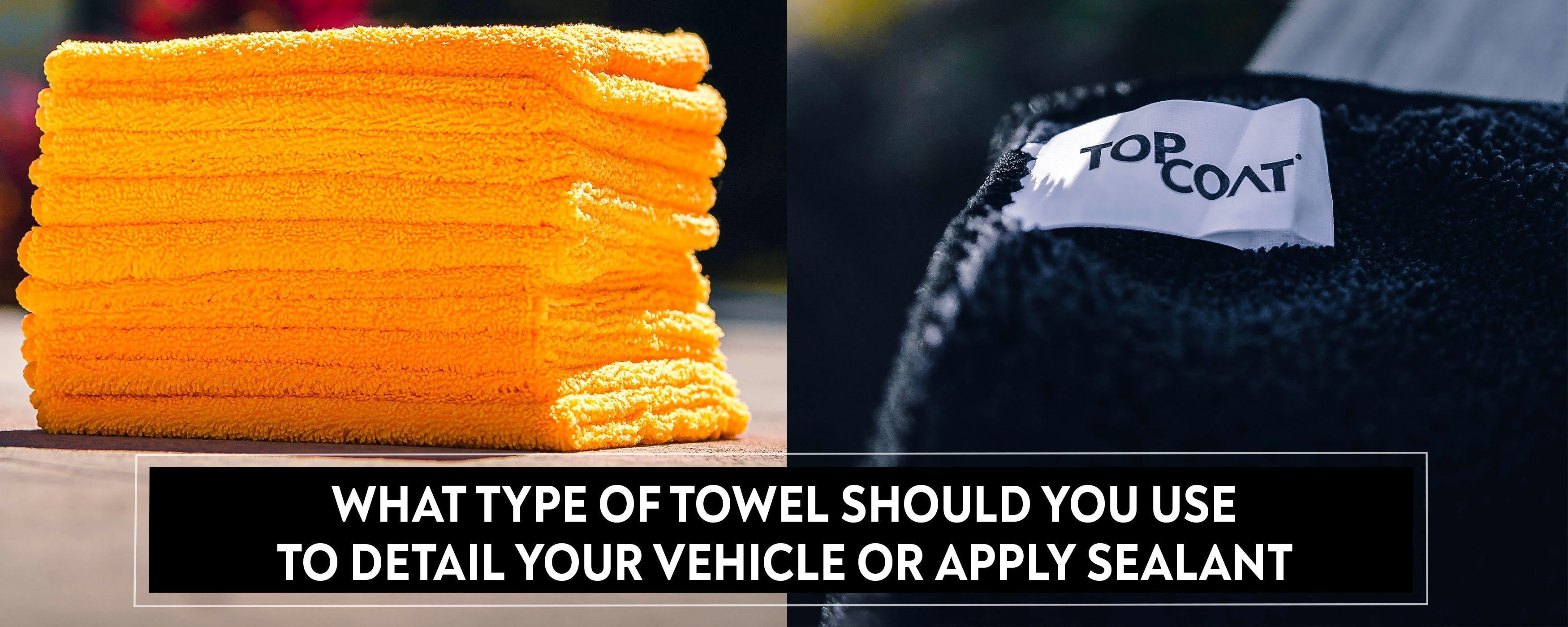GET 2 FREE TOWELS + FREE SHIPPING* WHEN YOU SPEND $75
*Applies to lower 48 states in USA
FREE DETAILING ADVICE +1-877-838-2672

When it comes to washing your car or applying a sealant, the type of towel you use is one of the most important choices you’ll make, and you’ll be glad you made the right choice for many reasons.
Detailing your vehicle is so much more than just the chemicals that you use. You must pay special attention to what products you use to apply those chemicals, and your method for buffing in products like sealants. It all comes down to what type of towel you use whether your detailing job turns out the best it can without causing unwanted damage through scratching the surface or leaving behind unsightly streaks, water marks, or micro-scratches.
It’s pretty clear that a microfiber towel is the right choice for detailing your vehicle, drying it, and for application of a sealant. However, microfiber towels are not all created equal and certain types of microfiber towels are best for different applications for the best results.
Microfiber towels are made up of a synthetic blend of fibers, usually polyester and polyamide. The ratio of polyester and polyamide is usually around 70/30 or 80/20 but does not necessarily correlate with the quality of the towel. Ultimately, the quality of a microfiber towel is how tightly woven it is along with a high pile design, and the overall softness where it is absorbent yet effective for collecting loose elements without scratching a surface.
There are different ranges of microfiber towels, such as waffle wave, twisted loop, and chamois, with some having a thick high pile with a high GSM (grams per square meter) number. The overall characteristic of microfiber towels is that they are the best choice for detailing vehicles because they are the least likely to scratch the surface. However, choosing the right microfiber towel is important because different types are best suited for certain detailing jobs.
Detailing Microfiber Towel
A microfiber towel used for detailing, which is the one that will act as your washcloth saturated with your soap and water, should have a GSM of around 350 to 400. Such medium-density and high-fiber microfiber towels are very soft and absorbent and won’t scratch the surface when saturated with soap and water, and they may also be used dry for buffing and polishing (sealant application).
Drying Microfiber Towel
A drying microfiber towel should first be a larger towel and have a GSM of around 350 or more. Some drying microfiber towels are larger than your detailing microfiber towel so they may cover more surface area reducing overuse of a singular surface area, which helps reduce the risk of scratching a surface that’s being dried. Chamois towels are not recommended even though they may absorb a lot of water – they are not as forgiving as a waffle wave or twisted loop microfiber and can easily scratch the surface if there is any trace of a hard element on the surface. Be sure that your choice of a drying microfiber towel is of medium-density, high-fiber, has bounded edging, and has removable tags to help prevent unwanted scratching.
Buffing and Polishing Microfiber Towel
A microfiber towel used for buffing and polishing (sealant application) can be the same type that you use for initial detailing. However, a higher GSM of around 400 or more will be the most effective for polishing and buffing surfaces (sealant application) as there are more microfibers per square inch. A bordered design is also beneficial to help reduce the chances of scratching on a surface that is being buffed or polished dry.
TopCoat® Mycropro® 18 Professional Microfiber Towels – Recommended for washing/detailing, polishing, and buffing (sealant application/applying TopCoat® F11®, F11PRO®, Spritz®, PolyWash®, Crystaleen®, and more). This towel can also be used as a quick-drying towel for smaller areas.
TopCoat® Mycro 16 Premium Detail Microfiber Towels – Recommended for washing/detailing, polishing, and buffing (sealant application/applying TopCoat® F11®, F11PRO®, Spritz®, PolyWash®, Crystaleen®, and more).
TopCoat® Ginormous 54”x27” Drying Microfiber Towel – Recommended for drying washed surfaces.
TopCoat® LuvGluv® Hand Mycromitt – Recommended for tight spaces and crevasse for wash/detailing, polishing, buffing, and light drying.
Pro Tip: Using a brightly-colored microfiber towel, such as our ultra-white TopCoat® Mycropro 18 Professional Microfiber Towel, will help reveal dirt and debris so you can then make adjustments to prevent unwanted damage to your surface. You’ll also want to ensure that you can remove any tags on microfiber towels.

We want you to be 100% satisfied with everything you buy from TopCoat. And if you’re not entirely happy with your purchase we will refund your money in full, or exchange the goods. All we ask is that you contact our customer services and then return the products back to us.